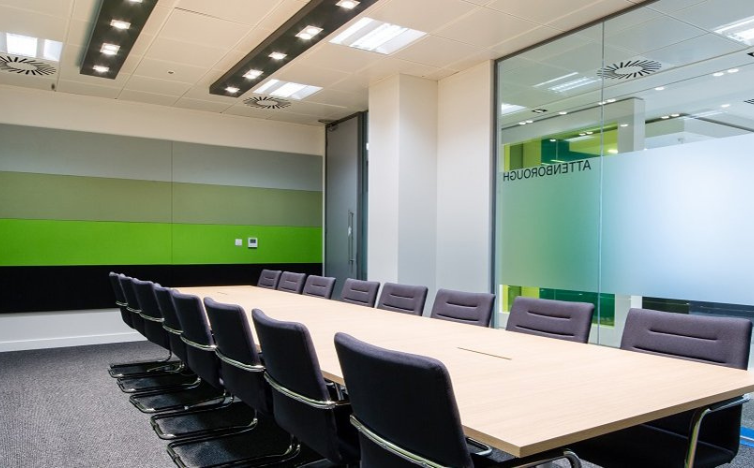In modern conference rooms, clear communication is crucial. Whether for meetings, presentations, or virtual calls, poor acoustics can disrupt the flow of conversation and hinder productivity. Acoustic wall panels provide an effective solution to manage sound, reduce echoes, and create a professional, focused environment. This article explores the benefits, installation tips, and best practices for using acoustic wall panels in conference rooms.
Why Acoustic Wall Panels Are Essential for Conference Rooms
Acoustic wall panels are designed to absorb sound waves, preventing echoes and minimizing noise. In conference rooms, where discussions and presentations are a key focus, good acoustics are essential. Clear communication can enhance decision-making, ensure better understanding among participants, and boost overall productivity.
Benefits of Using Acoustic Wall Panels
1. Improved Sound Clarity
One of the main advantages of acoustic wall panels is their ability to absorb excess noise and reverberations. This helps create a clear and crisp sound environment, making it easier for attendees to hear and understand each other, even during virtual meetings.
2. Enhanced Privacy
Acoustic panels reduce sound transmission between rooms. In conference rooms, this can prevent confidential discussions from being overheard, ensuring privacy and security during important meetings.
3. Aesthetic Appeal
Modern acoustic panels come in various colors, textures, and designs. This allows conference rooms to maintain a stylish appearance while also enhancing acoustics. The panels can blend seamlessly with the room’s decor or act as a visual feature.
How Acoustic Wall Panels Work
Acoustic wall panels are made from sound-absorbing materials like foam, fabric, or fiberglass. These materials are designed to trap sound waves, reducing the reflection of sound back into the room. By doing so, they limit the amount of echo and background noise, creating a more controlled audio environment. This makes conversations clearer and reduces strain on speakers and listeners alike.

Choosing the Right Acoustic Wall Panels for Your Conference Room
When selecting acoustic panels for a conference room, consider the following factors:
1. Size and Shape of the Room
Larger rooms may require more panels or a combination of wall and ceiling panels to effectively manage sound. The shape of the room can also impact how sound travels, influencing where panels should be placed for maximum effectiveness.
2. Panel Material and Thickness
Different materials have varying sound absorption capabilities. Thicker panels or those with higher noise reduction ratings are better at absorbing low-frequency sounds, making them ideal for conference rooms with heavy audio-visual usage.
3. Design and Aesthetics
Choose panels that match the room’s aesthetic while still offering effective sound management. Many manufacturers provide customizable options, allowing you to pick colors and patterns that suit your brand or the ambiance of the conference room.
See Also: Acoustic Wall Panels for Offices: Enhance Work Environment
Best Practices for Installing Acoustic Wall Panels
1. Strategic Placement
To maximize the effectiveness of acoustic wall panels, position them on walls where sound reflections are most problematic. This often includes the walls directly facing the speaker or around the areas where discussions are most frequent.
2. Combine with Other Acoustic Solutions
In some cases, wall panels alone might not be enough. Consider combining them with other acoustic solutions like ceiling panels, carpets, and heavy curtains for a comprehensive approach to soundproofing.
3. Regular Maintenance
Acoustic panels should be regularly checked for dust or wear and tear. Proper maintenance ensures that they remain effective over time, maintaining sound clarity and a professional appearance.
Tips for Maintaining a Professional Sound Environment
1. Limit Distractions
Beyond using acoustic panels, encourage minimal noise by limiting external distractions like hallway chatter or machinery noise near conference rooms. A quiet environment complements the effectiveness of acoustic solutions.
2. Use High-Quality Equipment
Quality microphones, speakers, and video conferencing tools further enhance the audio clarity in a conference room. Even the best acoustic panels can’t compensate for substandard audio equipment.
3. Monitor Room Acoustics Regularly
Acoustics can change as the room’s furniture and layout evolve. Regularly assessing the room’s sound environment can help ensure that your acoustic panels are positioned effectively and working as intended.
Call us: Contact DeSound Soundproofing Expert in Dubai For Soundproofing: +971 56 231 4204
Conclusion
Acoustic wall panels are a simple yet impactful solution to improve sound clarity in conference rooms. They help maintain professionalism, enhance communication, and create a comfortable environment for meetings and presentations. With the right choice and placement, acoustic panels can transform any conference room into a productive and private space, fostering better discussions and more effective decision-making. Investing in quality acoustic solutions is an investment in the overall success of your business or organization.

